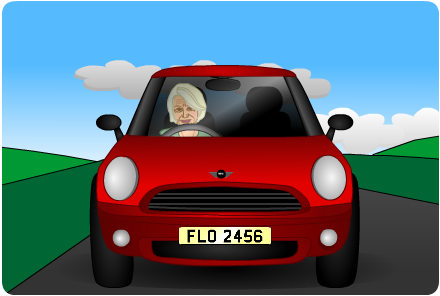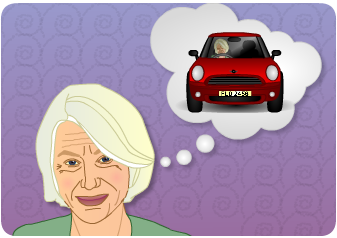
It is now 18 months since Flora had her stroke and there have been some very difficult times for her and her husband.
However, she is now an independent driver with her adapted Mini Cooper which she is thrilled to be able to drive again. She regularly collects her grandchildren from school and assists with the child care. Her husband unfortunately had to give up driving as his condition has progressed but their social life continues to be very active.
Modifications to any car will be tailored to individual need.
Adaptation photograph supplied by: Ricability (Research and information for older and disabled people)
Recommendations
Following her driving assessment at the centre the recommendations made were that;
- She requires vehicle adaptations to accommodate her physical disability
- Automatic transmission
- Steering wheel ball (no secondary electrical control unit needed)
- These could be accommodated by her present car.
- Flora has been off the road for several months now and needs to adjust to these new controls. Lessons with a school of motoring may be recommended by the centre following assessment. Following lessons, the instructor may write to the centre, if requested, stating the progress and a decision is then made by the centre and the referring doctor informed of the outcome. In Flora’s case the outcome is positive, and she can inform the DVLA of the modifications necessary for her to drive safely so these modifications can be coded on her licence.
- Once she receives her driving licence from the DVLA she must inform her insurance company
- about her stroke
- that she is considered fit to drive
- of the modifications that will allow her to drive safely
Further information :
Flora was then assessed using the Stroke Driver Screening Assessment. This is widely used as a screening tool of readiness to go back to driving but should not be administered prescriptively. Flora does not pass the screening tool as she takes excessive time to complete it which raises some concerns about her abilities. See Additional information box below for more information on the Stroke Driver Screening Assessment (SDSA).
Here, they would be able to identify any problems caused by her stroke and make recommendations about her safety to return to driving.
Flora’s GP refers her to the driving assessment centre. She also advises Flora to apply to DVLA for her licence which she had previously surrendered, ideally once she has an appointment from the driving assessment centre, in order for her to be able to be assessed for driving.
For further information on driving refer to the following information:
 Flora discusses her concerns with her GP at her next visit. The GP feels she has made considerable improvement. With Flora’s agreement, she is referred to an occupational therapist for further assessment with regard to return to driving.
Flora discusses her concerns with her GP at her next visit. The GP feels she has made considerable improvement. With Flora’s agreement, she is referred to an occupational therapist for further assessment with regard to return to driving.
The occupational therapist completes a functional assessment to determine Flora’s physical, cognitive and perceptual abilities.
Summary of Occupational Therapy assessment
- Flora is independently mobile within the house and uses her walking stick for outdoor mobility.
- She is able to use her left arm and hand for gross motor tasks but does not have fine motor functional return.
- However Flora is able to complete the majority of personal and household tasks using adaptive strategies e.g. using belly clamp and one touch tin opener when preparing food.
- She demonstrated cognitive and perceptual skills for complex domestic tasks i.e.
- Able to divide attention
- Able to adapt and improvise in unfamiliar situations
- There is now no evidence of residual visual inattention.
 You continue to see Flora over the next few months.
You continue to see Flora over the next few months.
She has continued to make progress and compensates well for her residual deficits which include reduced function in her left upper limb. Her cognitive functioning and visuospatial inattention have also improved.
She wonders if she will ever return to driving and worries about her husband’s driving abilities as his reactions have become much slower, he has had a few “near misses” and one minor accident. She feels that they will have to increasingly depend on others for transport and this has resulted in lowering of her mood. In light of this information, you advise Flora’s husband to discuss his ability to drive with his GP and advise him to inform DVLA of his progressive condition.
The topic of a driving assessment service is raised but she worries about having to sit a test as she passed her original driving test over 40 years ago. You reassure Flora that a driving assessment is not a driving test. It is used to clarify whether or not you are ready to go back to driving.
Flora is reviewed after 3 months. Flora tells you that she is seeing her GP again later this week and as she is now feeling fine she is going to ask her GP if she can return to driving.
You discuss her residual problems and her continuing lack of awareness into her problems. You discuss the legal position in relation to DVLA and clinically apparent visual inattention. Flora is reminded that it is still very early in her stroke recovery and allowing further time for ongoing recovery: physical, cognitive and perceptual, would be beneficial. With her level of impairment a 1 year post stroke recovery period is likely to be more realistic for considering her medical fitness for a return to driving, with a referral to a specialist driving assessment service being recommended.
You visit Flora in the community. She has continued to make progress and is now mobilising unaided. Whilst in her home you observe that she still has mild visuospatial inattention.
You note that she:
- is unable to locate remote control on her left side to turn down the television
- knocks over the milk carton which is on the work surface to her left when making tea
- has a burn on her left upper limb which she dismisses when you mention it
- has residual weakness in her left upper limb with limited functional use
- Flora reports to have successfully looked after her granddaughter for an afternoon the previous week. She states that she has an appointment with her GP the following week and is going to ask her to agree that she can return to driving as she is more than one month post stroke. Flora feels she has made enough recovery to drive safely.
When she is in the bathroom Flora’s husband tells you that he is concerned about her safety as she regularly bumps into objects on her left hand side. He has tried to raise his concerns with Flora as he feels she is not safe to drive but she refuses to acknowledge that there is a problem.

 Flora discusses her concerns with her GP at her next visit. The GP feels she has made considerable improvement. With Flora’s agreement, she is referred to an occupational therapist for further assessment with regard to return to driving.
Flora discusses her concerns with her GP at her next visit. The GP feels she has made considerable improvement. With Flora’s agreement, she is referred to an occupational therapist for further assessment with regard to return to driving. You continue to see Flora over the next few months.
You continue to see Flora over the next few months.

